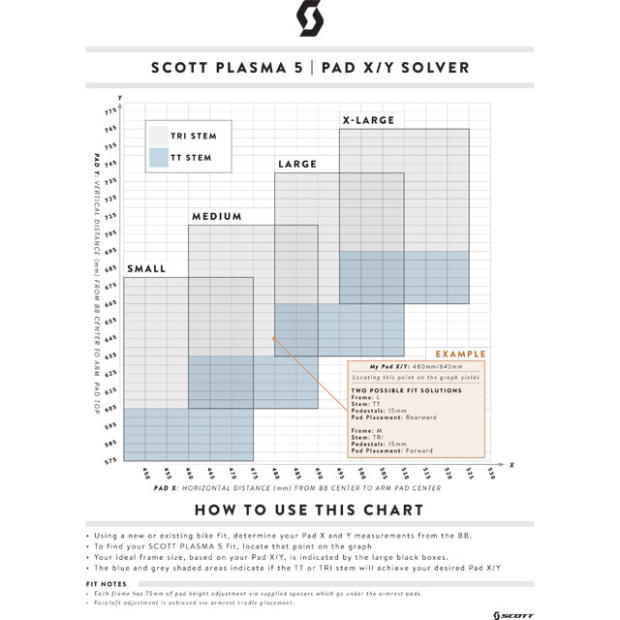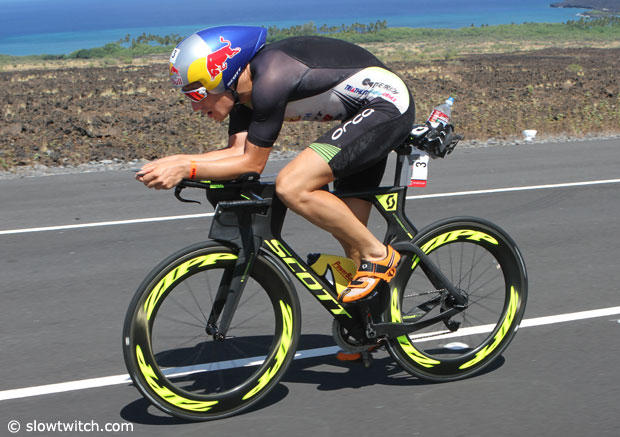The Plasma Gets a Prescriber
It is a head-scratcher why this bike has not been a better seller. A part of the problem was the spec, back in 2014 when Kienle won Kona. There was no electronic shift system for this bike. That has since changed. Here is a Di2 Plasma Premium on Nytro's site for a tick under $7000 complete.
Scott's well-regarded Plasma has been a visible presence in triathlon since its introduction. Hard-riding, Kona-winning Sebastian Kienle as well as Luke McKenzie, Flora Duffy and others ride Scott's fine bikes.
But there has been another issue with this bike, which is the lack of a prescriber or solver. Trek, Felt, Quintana Roo, Cervelo, TriRig, Giant, you name it, most of the important brands have Pad X/Y solvers and by this I mean if you know the X and Y dimensions from the bottom bracket to the pads (either to the rear or center of the pad) there is a "prescription" given you by the brand. You're a Trek Speed Concept, size L, low/far stem, 35mm pedestal, pads pulled back 20mm from neutral.

This has allowed Trek to sell its Speed Concept well in spite of a truly inept national dealer network (that is to say, a truly great dealer network that is truly inept at sizing and selling tri bikes). How useful is Trek's solver? As of this writing there are about 8,500 posts on the Trek Speed Concept Owners thread which consists of, mostly, "Hey, Carl, I'm 625×495," and Trek engineer Carl Matson answers with a prescription like that listed above. The customer goes to a Trek dealer, says, "I'll take a Speed Concept, Project One," gives the prescription and hands over the credit card, and the Trek store employee, having no flipping idea what the consumer just recited, charges the card and a month later another SC arrives. The dealer accepts a UPS shipment, takes the bike out of the box (probably with a blurry knowledge of how the transaction occurred) and the new SC owner rides off into the sunset.
Scott didn't have such a prescribing tool. Now it does.
Scott uses the rectangle (or parallellogram) motif, which I think is wise. It's easy to see all sizes on one chart, and it's easy to read. If your Pad X/Y (this chart uses pad-center, not pad-rear) is sitting on the bottom of a rectangle that means the bike in that size fitted to you will be slammed (you won't be able to go any lower). If the pads sit 20mm above the bottom of the rectangle you pedestal the pads 20mm.

Now, to be clear, you don't have every bit of adjustability in these rectangles. You have 3 fore/aft options inside these rectangles: dead center, forward 15mm, and rearward 15mm, because fore/aft is actuated by moving the pad cradles forward or rearward (or center) and each cradle has holesets 15mm apart from each other.
Scott was wise to place this sizer on a page that can be printed out on a letter-sized piece of paper. Quintana Roo did the same thing. Now a fitter or retailer can print it out, laminate it, sit it next to the fit station and prescribe the bike after the fit is done just by reading off this laminated sheet. Click here to download a printable version.
What about mortal Plasmas, such as the Plasma 10 and 20, which are loosely based on the Premium but use standard stems and which might sell for down to $2,200? We use a different process to prescribe a precise complete bike solution based on a rider's fit coordinates. For these bikes, just as with other mortal bikes like Cervelo's P2 and P3, the process is just as granular, just as effective, but does not reply on the Pad X/Y solver.





Start the discussion at slowtwitch.northend.network